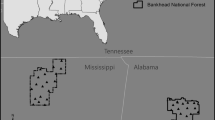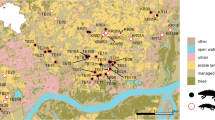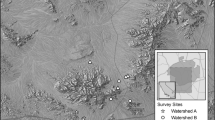Abstract
Dispersal is a foundational ecological and evolutionary process that facilitates population connectivity and resiliency and yet is vastly understudied. With landscape genetics, we can elucidate how environmental features and patch characteristics influence gene flow and therefore dispersal. Our main objective was to investigate how landscape features influence gene flow in the black-capped vireo source-sink system in central Texas. We genotyped 338 black-capped vireos at 12 microsatellite loci from 6 differentiated populations to test the relationships of Euclidean distance, elevation, and land cover types (water, development, forest, scrub, open, agriculture and riparian) with gene flow. We also tested how at-site variables, brown-headed cowbird control and area of scrub habitat, affected gene flow in our models. We found that riparian and agricultural areas facilitate gene flow while development and open habitat impede gene flow. Agriculture as a potential corridor was an unexpected finding in need of further study but indicates an exciting new avenue for black-capped vireo dispersal research. In combination with findings from Dittmar et al. (2014), we inferred that riparian areas may be important corridors for black-capped vireo dispersal during post-fledgling movements, particularly in fragmented landscapes. Therefore, protecting riparian areas may help mitigate the isolating effects of habitat fragmentation and would be an important conservation effort as habitat fragmentation continues in the future.



Similar content being viewed by others
References
Adamack AT, Gruber B (2014) PopGenReport: simplifying basic population genetic analyses in R. Methods Ecol Evol 5(4):384–387
Aguillon SM, Fitzpatrick JW, Bowman R, Schoech SJ, Clark AG, Coop G, Chen N (2017) Deconstructing isolation-by-distance: the genomic consequences of limited dispersal. PLoS Genet 13:8
Amarasekare P (2004) The role of density-dependent dispersal in source-sink dynamics. J Theor Biol 226(2):159–168
Athrey G, Lance RF, Leberg PL (2012) How far is too close? restricted, sex-biased dispersal in black-capped vireos. Mol Ecol 21(17):4359–4370
Barber DR, Martin TE (1997) Influence of alternate host densities on brown-headed cowbird parasitism rates in black-capped vireos. The Condor 99:595–604
Barr KR, Lindsay DL, Athrey G, Lance RF, Hayden TJ, Tweddale SA, Leberg PL (2008) Population structure in an endangered songbird: maintenance of genetic differentiation despite high vagility and significant population recovery. Mol Ecol 17(16):3628–3639
Bates D, Mächler M, Bolker BM, Walker SC (2015) Fitting linear mixed-effects models using lme4. J Stat Soft 67(1)
Burnham KP, Anderson DR (2002) Model selection and multimodel inference: A practical information-theoretic approach
Callens TOM, Galbusera P, Matthysen E, Durand EY, Githiru M, Huyghe JR, Lens LUC (2011) Genetic signature of population fragmentation varies with mobility in seven bird species of a fragmented Kenyan cloud forest. Mol Ecol 20(9):1829–1844
Cimprich DA, Kostecke RM (2006) Distribution of the black capped vireo at Fort Hood, Texas. Southwestern Naturalist 51(1):99–102
Clark RW, Brown WS, Stechert R, Zamudio KR (2008) Integrating individual behaviour and landscape genetics: the population structure of timber rattlesnake hibernacula. Mol Ecol 17(3):719–730
Cushman SA, Mcrae B, Adriaensen F, Beier P, Shirley M, Zeller K (2013) Biological corridors and connectivity. Key Topics Conser Biol 2:384–404
DeGraaf RM, Yamasaki M (2003) Options for managing early-successional forest and shrubland bird habitats in the northeastern United States. For Ecol Manage 185(1–2):179–191
Diffendorfer JE (1998) Testing models of source-sink dynamics and balanced dispersal. Oikos 81(3):417–433
Dittmar EM, Cimprich DA, Sperry JH, Weatherhead PJ (2014) Habitat selection by juvenile black-capped vireos following independence from parental care. J Wildlife Manag 78(6):1005–1011
Donald PF, Evans AD (2006) Habitat connectivity and matrix restoration: The wider implications of agri-environment schemes. J Appl Ecol 43(2):209–218
Dunning JB, Danielson BJ, Pulliam HR (1992) Ecological processes that affect populations in complex landscapes. Oikos 65(1):169–175
Emaresi G, Pellet J, Dubey S, Hirzel AH, Fumagalli L (2011) Landscape genetics of the Alpine newt (Mesotriton alpestris) inferred from a strip-based approach. Conserv Genet 12(1):41–50
Fitzpatrick BM, Shaffer HB (2007) Introduction history and habitat variation explain the landscape genetics of hybrid tiger salamanders. Ecol Appl 17(2):598–608
Gadgil M (1971) Dispersal: population consequences and evolution. Ecology 52(2):253–261
Gandon S (1999) Kin Competition, the Cost of Inbreeding and the Evolution of Dispersal. J Theor Biol 200(4):345–364
Gandon S, Michalakis Y (1999) Evolutionarily stable dispersal rate in a metapopulation with extinctions and kin competition. J Theor Biol 199:275–290
Greenwald KR, Gibbs HL, Waite TA, Lisle Gibbs H (2009) Efficacy of landcCover models in predicting isolation of marbled salamander populations in a fragmented landscape efficacy of land-cover models in predicting isolation of marbled salamander populations in a fragmented land. Conserv Biol 23(5):1232–1241
Gruber B, Adamack A (2017) Package “PopGenReport” Title A Simple Framework to Analyse Population and Landscape Genetic Data. R Help
Grzybowski JA, Tazik DJ, Schnell GD (1994) Regional analysis of black-capped vireo breeding habitats. The Condor 96(2):512–544
Gundersen G, Andreassen HP, Ims RA (2002) Individual and population level determinants of immigration success on local habitat patches: an experimental approach. Ecol Lett 5(2):294–301
Hauser SS, Walker L, Leberg PL (2019) Asymmetrical gene flow of the recently delisted passerine black-capped vireo (Vireo atricapilla) indicates source-sink dynamics in central Texas. Ecol Evol 9(1):463–470
Heinrichs JA, Lawler JJ, Schumaker NH, Wilsey CB, Bender DJ (2015) Divergence in sink contributions to population persistence. Conserv Biol 29(6):1674–1683
Heinrichs JA, Lawler JJ, Schumaker NH, Wilsey CB, Monroe KC, Aldridge CL (2018) A multispecies test of source–sink indicators to prioritize habitat for declining populations. Conserv Biol 32(3):648–659
Hipkiss T, Hornfeldt B, Lundmark A, Norback M, Ellegren H (2002) Sex ratio and age structure of nomadic Tengmalm’s owls: a molecular approach. J Avian Biol 33(1):107–110
Jackson ND, Fahrig L (2016) Habitat amount, not habitat configuration, best predicts population genetic structure in fragmented landscapes. Landscape Ecol 31(5):951–968
Jenkins DG, Carey M, Czerniewska J, Fletcher J, Hether T, Jones A, Knight S et al (2010) A meta-analysis of isolation by distance: relic or reference standard for landscape genetics? Ecography 33(2):315–320
Johnson D (2004) Source–sink dynamics in a temporally heterogeneous environment. Ecology 85(7):2037–2045
Jombart T (2008) Adegenet: A R package for the multivariate analysis of genetic markers. Bioinformatics 24(11):1403–1405
Kekkonen J, Hanski IK, Jensen H, Väisänen RA, Brommer JE (2011) Increased genetic differentiation in house sparrows after a strong population decline: from panmixia towards structure in a common bird. Biol Conserv 144(12):2931–2940
Keller D, Holderegger R, van Strien MJ, Bolliger J (2015) How to make landscape genetics beneficial for conservation management? Conserv Genet 16(3):503–512
Kostecke RM, Cimprich Da (2008) Adult and Juvenile survival of black-capped vireos within a large breeding population in Texas. The Condor 110(2):251–259
Kostecke RM, Summers SG, Eckrich GH, Cimprich DA (2005) Effects of brown-headed cowbird (Molothrus ater) removal on black-capped vireo (Vireo atricapilla) nest success and population growth at Fort Hood, Texas. Ornithol Monogr 57(57):28–37
Lawler JJ, Marzluff JM, Kostecke RM, Cimprich DA, Heinrichs J, Walker L, Heimbuch M et al (2016) Sources and Sinks: Elucidating Mechanisms, Documenting Patterns, and Forecasting Impacts. SERDP Project RC-212- Final Report, 1–206
Levins R (1969) The effect of random variations of different types on population growth. Proc Natl Acad Sci USA 62(4):1061–1065
Marzluff JM, Balda RP (1989) Causes and consequences of female-based dispersal in a flock-living bird, the Pinyon jay. Ecology 70(2):316–328
McFarland TM, Mathewson HA, Groce JE, Morrison ML, Wilkins RN (2013) A range-wide survey of the endangered black-capped vireo in Texas. Southeast Nat 12(1):41–60
McRae BH, Dickson BG, Keitt TH, Shah VB (2008) Using circuit theory to model connectivity in ecology, evolotion and conservation. Ecology 89(10):2712–2724
Miller MP (2005) Alleles In Space (AIS): Computer software for the joint analysis of interindividual spatial and genetic information. J Hered 96(6):722–724
Murphy M (2016) Package ‘ GeNetIt.’ R Help
Murphy MA, Dezzani R, Pilliod DS, Storfer A (2010) Landscape genetics of high mountain frog metapopulations. Mol Ecol 19(17):3634–3649
Nowakowski AJ, Dewoody JA, Fagan ME, Willoughby JR, Donnelly MA (2015) Mechanistic insights into landscape genetic structure of two tropical amphibians using field-derived resistance surfaces. Mol Ecol 24(3):580–595
Palo JU, Lesbarrères D, Schmeller DS, Primmer CR, Merilä J (2004) Microsatellite marker data suggest sex-biased dispersal in the common frog Rana temporaria. Mol Ecol 13(9):2865–2869
Paradis E, Baillie SR, Sutherland WJ, Gregory RD (1998) Patterns of natal and breeding dispersal in birds. J Anim Ecol 67(4):518–536
Pye JM, Rauscher HM, Sands Y, Lee DC, Beatty JS (2010) Advances in threat assessment and their application to forest and rangeland management—Volume 1 and Volume 2. Gen. Tech. Rep. PNW-GTR-802. Portland, OR: US Department of Agriculture, Forest Service, Pacific Northwest and Southern Research Stations. 708 p, 802
Raymond M, Rousset F (1995) GENEPOP (version 1.2): population genetics software for exact tests and ecumenicism. J Hered 86:248–249
Ripperger SP, Tschapka M, Kalko EK, Rodríguez-Herrera BV, Mayer F (2014) Resisting habitat fragmentation: high genetic connectivity among populations of the frugivorous bat Carollia castanea in an agricultural landscape. Agric Ecosyst Environ 185:9–15
Roff DA (1975) Population stability and the evolution of dispersal in a heterogeneous environment. Oecologia 19(3):217–237
Runge JP, Runge MC, Nichols JD (2006) The role of local populations within a landscape context: defining and classifying sources and sinks. Am Nat 167(6):925–938
Sharma S, Dutta T, Maldonado JE, Wood TC, Panwar HS, Seidensticker J, Slatkin M et al (2013) Forest corridors maintain historical gene flow in a tiger metapopulation in the highlands of central India. Proc Biol Sci R Soc 280(1767):1–7
Shirk AJ, Landguth EL, Cushman SA (2017) A comparison of individual-based genetic distance metrics for landscape genetics. Mol Ecol Resour 17(6):1308–1317
Sorice MG, Kreuter UP, Wilcox BP, Fox WE III (2012) Classifying land-ownership motivations in central, Texas, USA: A first step in understanding drivers of large-scale land cover change. J Arid Environ 80:56–64
Stronen AV, Schumaker NH, Forbes GJ, Paquet PC, Brook RK (2012) Landscape resistance to dispersal: simulating long-term effects of human disturbance on a small and isolated wolf population in southwestern Manitoba, Canada. Environ Monit Assess 184(11):6923–6934
Tamarin RH (1978) Dispersal, population regulation, and K-selection in field mice. Am Nat 112(985):545–555
Vance RR (1984) The effect of dispersal on population stability in one-species, discrete-space population-growth models. Am Nat 123(2):230–254
Velo-Antõn G, Parra JL, Parra-Olea G, Zamudio KR (2013) Tracking climate change in a dispersal-limited species: reduced spatial and genetic connectivity in a montane salamander. Mol Ecol 22(12):3261–3278
Walker LE, Marzluff JM, Cimprich DA (2016) Source-sink population dynamics driven by a brood parasite: a case study of an endangered songbird, the black-capped vireo. Biol Conserv 203:108–118
Woltmann S, Kreiser BR, Sherry TW (2012) Fine-scale genetic population structure of an understory rainforest bird in Costa Rica. Conserv Genet 13(4):925–935
Yoder JM, Marschall EA, Swanson DA (2004) The cost of dispersal: predation as a function of movement and site familiarity in ruffed grouse. Behav Ecol 15(3):469–476
Zeller KA, McGarigal K, Whiteley AR (2012) Estimating landscape resistance to movement: a review. Landscape Ecol 27(6):777–797
Acknowledgements
We would like to thank our funding agency, the Strategic Environmental Research and Development Program (SERDP), Department of Defense, through project RC-2120 to J. Lawler. Special thanks to the private landowners, Texas State Parks and Wildlife, Colorado Bend State Park, Balcones Canyonlands National Wildlife Research, and the Natural Resources Division, particularly D. Cimprich and his team at Fort Hood for providing us access and resources for this research. Thanks to P. Byerly, S. Duke-Sylvester, B. Moon, J. Neigel, and J. Sperry for their valuable comments.
Author information
Authors and Affiliations
Corresponding author
Additional information
Publisher's note
Springer Nature remains neutral with regard to jurisdictional claims in published maps and institutional affiliations.
Rights and permissions
About this article
Cite this article
Hauser, S.S., Leberg, P.L. Riparian areas potentially provide crucial corridors through fragmented landscape for black-capped vireo (Vireo atricapilla) source-sink system. Conserv Genet 22, 1–10 (2021). https://doi.org/10.1007/s10592-020-01314-1
Received:
Accepted:
Published:
Issue Date:
DOI: https://doi.org/10.1007/s10592-020-01314-1




